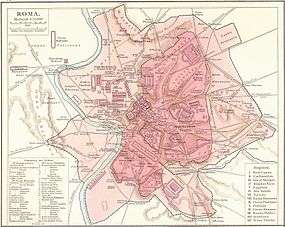Temple of Concord
Coordinates: 41°53′35″N 12°29′03″E / 41.89293°N 12.484245°E
| Temple of Concord | |
|---|---|
 | |
| Location | Regione VIII Forum Romanum |
| Built in | 4th Century BC |
| Built by/for | Unknown |
| Type of structure | Roman Temple |
| Related |
List of ancient monuments in Rome |
 Temple of Concord | |

The Temple of Concord in the ancient city of Rome was a temple dedicated to the Roman goddess Concordia at the western end of the Roman Forum. The temple was vowed in 367 BC by Marcus Furius Camillus but was not built until 167 BC.[1] It was destroyed and restored multiple times in its history, and its final restoration, between 7 and 10 AD under the future Roman Emperor Tiberius, is described in Pliny the Elder's Natural History. In approximately AD 1450 the temple was razed and turned into a lime kiln to recover the marble for building.
History
Roman literature states that it was first vowed by Marcus Furius Camillus in 367 BC to commemorate the Leges Liciniae Sextiae of Lucius Sextius Lateranus and the resulting reconciliation between the patricians and plebeians after the Aventine Secession.
It was a frequent focus for fostering harmony in the Roman state, both through its first rebuilding in 121 BC (after the murder of Gaius Gracchus), and through its occasional use for meetings of the Senate, especially in times of civil disturbance (Cicero delivered his fourth Catilinarian oration here).
It was again restored between 7 and 10 AD by Tiberius as Augustus's heir, to better use the limited available area on the site. He probably rededicated it in AD 12. This restoration was distinguished by its opulent marble and rich architectural ornamentation, and Tiberius's housing of numerous Greek paintings, sculpture and other works of art there (listed in Pliny's Natural History), making it something akin to an art museum.
Architecture
Backed up against the Tabularium at the foot of the Capitoline Hill, the architecture had to accommodate the limitations of the site. The cella of the temple, for instance, is almost twice as wide (45m) as it is deep (24m), as is the pronaos. In the cella a row of Corinthian columns rose from a continuous plinth projecting from the wall, which divided the cella into bays, each containing a niche. The capitals of these columns had pairs of leaping rams in place of the corner volutes. Only the platform now remains, partially covered by a road up to the Capitol.
Empire
The main temple in the Forum in Rome seems to have been a model for temples to the goddess elsewhere in the empire – a reproduction of this temple was found in Mérida (Spain), during the excavations of the town's forum in 2002.
Notes
- ↑ Aicher, P.J. (2004). Rome Alive: A Source-Guide to the Ancient City Volume I. Bolchazy-Carducci. p. 94. ISBN 9780865164734. Retrieved 2014-12-11.
Sources
| Wikimedia Commons has media related to Temple of Concord (Rome). |
- Encyclopaedia Romana
- Gazeteer
- Merida excavations (in Spanish)
- Rome Alive